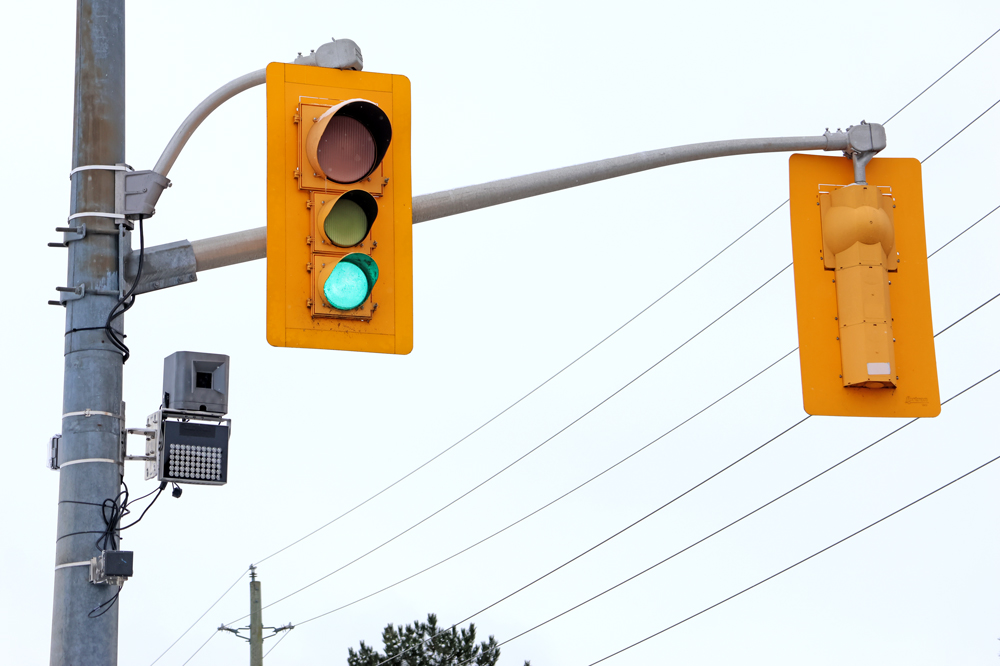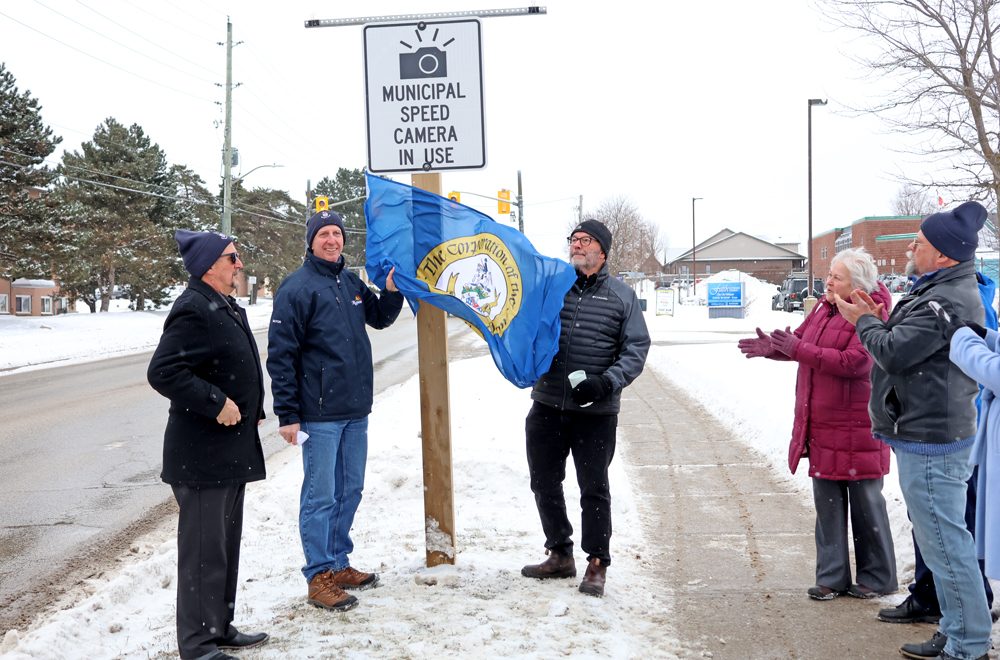FERGUS – Drivers in Wellington County have been warned, and now if they don’t watch their speed, they risk getting a nasty bill in the mail.
The county’s automated speed enforcement (ASE) pilot program officially went live in some designated school and community safety zones on Jan. 15.
Drivers who speed in those areas could end up with tickets mailed to them after the fact.
“We just want people to be compliant with the speed limit,” county councillor and roads committee chair Gregg Davidson said of the program.
He explained the point of the speed cameras is not to ticket more drivers or generate revenue for the county, but to get people to slow down.
“We hope it doesn’t generate anything,” he said, speaking following a Jan. 15 photo op where county councillors unveiled a sign reading “municipal speed camera in use” on Belsyde Avenue in Fergus.
Cameras are installed high up on the traffic light posts of the crosswalk in front of J.D. Hogarth school – one pointing east, and one pointing west, to capture speeders from either direction.
Asked whether the cameras would be functioning as soon as the sign was unveiled, county engineer Don Kudo said the signs must be visible before the cameras are turned on.
“We have the ability to start operating these cameras once the signs are up,” Kudo said.
Previous signs reading “municipal speed camera coming soon” were posted Oct. 7 on seven county roads with community safety zones – one for each of the county’s member municipalities.
The posting of those signs commenced the required 90-day warning period, after which the speed cameras can go live.
Along with the Centre Wellington camera in Fergus, three more locations were slated to go live on Jan. 15:
- Brock Road South in Aberfoyle, between Jane Street and Church Street;
- Main Street in Palmerston, between Henry Street and York Street; and
- Sligo Road East, from 50 metres west of Church Street to 125m west of London Road, in Mount Forest.
Three more locations are expected to go live soon:
- Wellington Street South in Drayton;
- Main Street North in Rockwood; and
- Trafalgar Road in Hillsburgh.
According to a Jan. 14 report to the county’s roads committee, these locations “still require approval from Hydro One to attach cameras to their poles.
“The approval is expected shortly and those cameras will be installed, tested and will go live as soon as possible.”
The cameras are part of a one-year pilot program that Davidson said has been in the works for years.
He said he first saw a presentation on automated speed enforcement in 2017.
“I have been on the bandwagon to bring it to the county ever since,” he said.

Small and inconspicuous, the speed cameras on Belsyde Avenue are mounted on the posts of the traffic lights at the crosswalk in front of J. D. Hogarth Public School. Photo by Jessica Lovell
Last spring, after receiving formal proposals from three vendors, the county began negotiations with Global Traffic Group for a contract to provide the cameras.
According to a “frequently asked questions” section on the county’s website, there is no cost to the municipality for the program.
“Global Traffic Group provides the technology and systems required for the program,” the website states.
“Revenue generated through the ASE program is split with the vendor.”
Asked what portion of the revenue would go to Global Traffic Group and what portion to the county, Davidson said the information is confidential.
“That’s part of a contract we cannot disclose,” he said.
It’s not clear how many tickets the county expects the cameras to issue, but the yet-to-be-approved 2025 budget includes a $1-million allocation of revenue expected to be received from the ASE pilot project.
“This amount will be transferred to reserves to facilitate future traffic improvements,” stated a report on the budget included in the agenda for the Jan. 14 roads committee meeting.
Councillor Michael Dehn, a fellow roads committee member, echoed Davidson’s sentiment that the program isn’t meant to be a revenue generator.
“This is all about community safety; it’s not about money,” said Dehn.
Asked about the fines people could expect from the cameras, Davidson said “the fine is exactly the same as you would get from police.”
Councillor Jeff Duncan added fines are doubled in community safety zones, whether tickets are issued by a police officer or machine.
Duncan said one of the most frequent questions he is asked about the cameras is what speed threshold triggers the camera, or how many kilometres above the speed limit does a driver have to be going to get a ticket.
“It is confidential,” said Duncan, explaining the idea is to keep people driving below the limit.
But, he added, “It’s similar to what a live police officer would pull you over for.”



